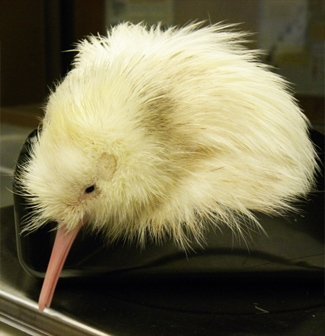Rare white kiwi bird hatches in NZ

AT LITTLE MORE THAN 300g, the most recently hatched kiwi chick at Pukaha Mount Bruce National Wildlife Centre, in New Zealand’s North Island, has the weight of a species on its shoulders.
The chick, which is covered in a shock of white feathers, is the seventh North Island brown kiwi (Apteryx mantelli) to hatch at the centre this season and the third white-coloured chick ever to be born in captivity.
Together, these young kiwi are helping to slow the decline of New Zealand’s iconic bird.
Third white kiwi chick hatched in New Zealand
The all-white chick, hatched last Monday, is the third of such colouring born at Pukaha since May last year.
“Kiwi in themselves are rare but to have a fully white-feathered kiwi is even more so, and these three represent the only three in captivity in the world,” says Pukaha board member Jason Kerehi.
Kathy Houkamau, manager at the Pukaha Wildlife Centre, agrees the occurrence is incredibly rare. “For it to occur, both parents need to be carrying the recessive white gene, which is very rare in itself, but even rarer still is the fact that two birds who were carrying that recessive gene found each other and mated.”
The chance of such a pair producing a white chick is only 25 per cent.
While their white colouring may make these chicks more visible to predators, they have the best possible chance of survival at Pukaha.
Captive breeding protects vulnerable baby birds
Birds within the nature reserve live as they would in the wild. However, males are tracked with transmitters and, after mating, eggs are collected from burrows and incubated at the centre.
Kiwi chicks are hand-reared and released back into the forest once they’ve reached a sub-adult weight of over 1kg. This generally occurs when they are about eight months old.
“The chicks are very vulnerable to predators so without intervention from us only about 5 per cent of them survive to adulthood,” says Kathy. This survival rate is too low to sustain the population.
“The little chicks are no competition against predators such as stoats or ferrets, so that’s why we collect the eggs,” Kathy says. “We get the chicks through that critical stage and then release them back into the same reserve when they are big enough to defend themselves, or at least able to run away.”
The breeding season runs from October to May and this year, it is already off to a flying start.
Conservation aimed at kiwi species in decline
The North Island brown is one of five species of kiwi, all of which are endemic to New Zealand. All of these species are in rapid decline: in total, there are only about 70,000 left and by 2018, that number is expected to drop to about 63,500.
To safeguard the birds from extinction, a number of conservation programs have been implemented across the country. They aim to re-establish local kiwi populations by reducing threats such as habitat loss and predation from feral animals, and by encouraging higher survival rates in newly hatched chicks.
It is for these reasons that, in 2010, 30 adult brown kiwis were translocated from Little Barrier Island (Hauturu) – a small island situated off the north-eastern coast of NZ’s North Island – to 940ha of native forest at Pukaha, at the southern end of the North Island.
“We’re intensively trapping the reserve to keep predator numbers low, to give the adults a chance to survive and breed, and to give the young ones a chance to grow,” Kathy says.
RELATED STORIES

